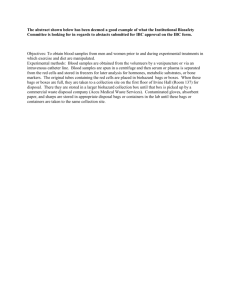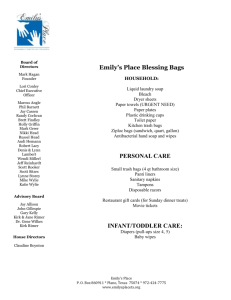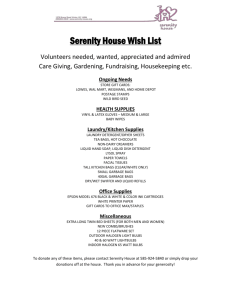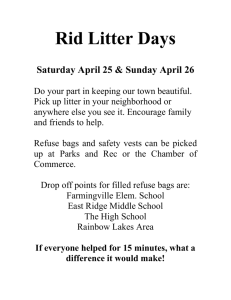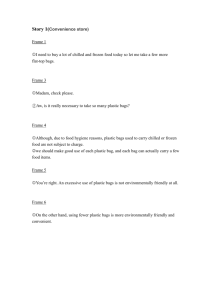Economics Review Problems & Answers - Unit 1
advertisement
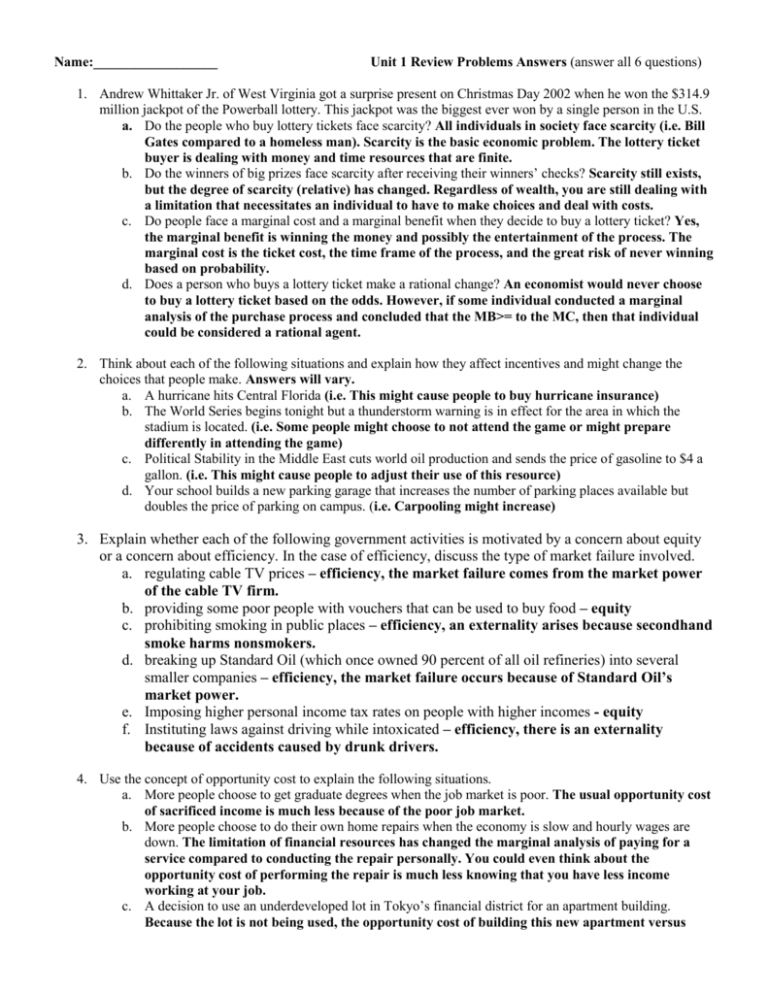
Name:__________________ Unit 1 Review Problems Answers (answer all 6 questions) 1. Andrew Whittaker Jr. of West Virginia got a surprise present on Christmas Day 2002 when he won the $314.9 million jackpot of the Powerball lottery. This jackpot was the biggest ever won by a single person in the U.S. a. Do the people who buy lottery tickets face scarcity? All individuals in society face scarcity (i.e. Bill Gates compared to a homeless man). Scarcity is the basic economic problem. The lottery ticket buyer is dealing with money and time resources that are finite. b. Do the winners of big prizes face scarcity after receiving their winners’ checks? Scarcity still exists, but the degree of scarcity (relative) has changed. Regardless of wealth, you are still dealing with a limitation that necessitates an individual to have to make choices and deal with costs. c. Do people face a marginal cost and a marginal benefit when they decide to buy a lottery ticket? Yes, the marginal benefit is winning the money and possibly the entertainment of the process. The marginal cost is the ticket cost, the time frame of the process, and the great risk of never winning based on probability. d. Does a person who buys a lottery ticket make a rational change? An economist would never choose to buy a lottery ticket based on the odds. However, if some individual conducted a marginal analysis of the purchase process and concluded that the MB>= to the MC, then that individual could be considered a rational agent. 2. Think about each of the following situations and explain how they affect incentives and might change the choices that people make. Answers will vary. a. A hurricane hits Central Florida (i.e. This might cause people to buy hurricane insurance) b. The World Series begins tonight but a thunderstorm warning is in effect for the area in which the stadium is located. (i.e. Some people might choose to not attend the game or might prepare differently in attending the game) c. Political Stability in the Middle East cuts world oil production and sends the price of gasoline to $4 a gallon. (i.e. This might cause people to adjust their use of this resource) d. Your school builds a new parking garage that increases the number of parking places available but doubles the price of parking on campus. (i.e. Carpooling might increase) 3. Explain whether each of the following government activities is motivated by a concern about equity or a concern about efficiency. In the case of efficiency, discuss the type of market failure involved. a. regulating cable TV prices – efficiency, the market failure comes from the market power of the cable TV firm. b. providing some poor people with vouchers that can be used to buy food – equity c. prohibiting smoking in public places – efficiency, an externality arises because secondhand smoke harms nonsmokers. d. breaking up Standard Oil (which once owned 90 percent of all oil refineries) into several smaller companies – efficiency, the market failure occurs because of Standard Oil’s market power. e. Imposing higher personal income tax rates on people with higher incomes - equity f. Instituting laws against driving while intoxicated – efficiency, there is an externality because of accidents caused by drunk drivers. 4. Use the concept of opportunity cost to explain the following situations. a. More people choose to get graduate degrees when the job market is poor. The usual opportunity cost of sacrificed income is much less because of the poor job market. b. More people choose to do their own home repairs when the economy is slow and hourly wages are down. The limitation of financial resources has changed the marginal analysis of paying for a service compared to conducting the repair personally. You could even think about the opportunity cost of performing the repair is much less knowing that you have less income working at your job. c. A decision to use an underdeveloped lot in Tokyo’s financial district for an apartment building. Because the lot is not being used, the opportunity cost of building this new apartment versus leaving it vacant is much less in comparison. Unless, it would make sense to build an additional financial building versus an apartment, but they have not indicated that. d. A decision to use a square mile in the desert for a gas station. The small amount of use in this natural resource makes the marginal benefit to be much greater than the marginal cost. 5. Analyze the positive versus normative arguments in the following case. What statements of positive economics are used to support requiring air bags? What normative reasoning is used? Should the government require air bags? Air bags advocates say air bags will save lives and the government should require them in all cars. Air bags add an estimated $600 to the cost of a car, compared to about $100 for a set of regular seat belts. Opponents argue that air bags are electronic devices that are subject to failure and have produced injuries and death. For example, air bags have killed both adults and children whose heads are within the inflation zone at the time of deployment. Opponents therefore believe the government should leave the decision of whether to spend an extra $600 or so for an air bag to the consumer. The role of government should be limited to providing information on the risks of having versus not having an air bag. Positive Economics Air bags add an estimated $600 to the cost of a car, compared to about $100 for a set of regular seat belts. Electronic devices that are subject to failure and have produced injuries and death. Air bags have killed both adults and children whose heads are within the inflation zone at the time of deployment. Normative Economics Air bags advocates say air bags will save lives and the government should require them in all cars. Opponents argue that air bags are electronic devices Government should leave the decision of whether to spend an extra $600 or so for an air bag to the consumer. Role of government should be limited to providing information on the risks of having versus not having an air bag. Final decision on whether or not to have air bags will have varied answers. 6. The table below is a set of hypothetical production possibilities for a nation. Combination Automobiles (thousands) Beef (thousands of tons) A 0 10 B 2 9 C 4 7 D 6 4 E 8 0 a. Plot these production possibilities data – creating an economic model. What is the opportunity cost of the first $2,000 automobiles produced? 1,000 tons of beef Between which points is the opportunity cost per thousand automobiles highest? Points D and E Between which points is the opportunity cost per thousand tons of beef highest? Points B and A b. Label a point F inside the curve. Why is this an inefficient point? This nation is not fully employing all resources available and ultimately not at full production. Label a point G outside the curve. Why is this point unattainable? This nation is dealing with a level of scarce resources making it impossible to produce beyond the frontier. Why are points A through E all efficient points? The nation is fully employing all resources and producing at full production. What point would the nation have to produce to reach allocative efficiency? The point where MB=MC and because not specified you would assume the point where resources are evenly divided between the two goods. In this situation, point C is the most optimal point. c. Does this production possibilities curve reflect the law of increasing opportunity costs? Explain. Yes, as you produce additional automobiles you incur a greater opportunity cost. The reason for this increasing aspect is because the transfer of resources is more complex and difficult. d. What assumptions could be changed to shift the production possibilities curve? Quantity of resources, Quality of resources, Cost of resources and technology changes.




